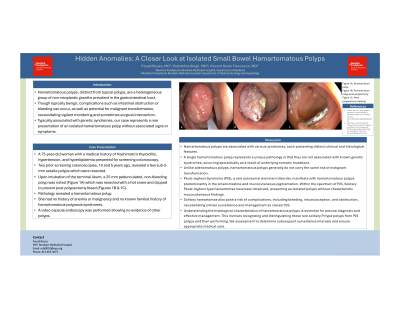Sunday Poster Session
Category: General Endoscopy
P0700 - Hidden Anomalies: A Closer Look at Isolated Small Bowel Hamartomatous Polyps
Sunday, October 27, 2024
3:30 PM - 7:00 PM ET
Location: Exhibit Hall E

Has Audio

Muhammad F. Bouso, MD, MS
New York-Presbyterian Brooklyn Methodist Hospital
Brooklyn, NY
Presenting Author(s)
Muhammad F. Bouso, MD1, Pratishtha Singh, MD2, Vincent N. Francesco, MD1
1New York-Presbyterian / Brooklyn Methodist Hospital, Brooklyn, NY; 2New York Brooklyn Methodist Hospital, Brooklyn, NY
Introduction: Hamartomatous polyps, distinct from typical polyps, are a heterogeneous group of non-neoplastic growths prevalent in the gastrointestinal tract. Though typically benign, complications such as intestinal obstruction or bleeding can occur, as well as potential for malignant transformation, necessitating vigilant monitoring and sometimes surgical intervention. Typically associated with genetic syndromes, our case represents a rare presentation of an isolated hamartomatous polyp without associated signs or symptoms.
Case Description/Methods: A 75-year-old woman with a medical history of Hashimoto’s thyroiditis, hypertension, and hyperlipidemia presented for screening colonoscopy. Two prior screening colonoscopies, 10 and 5 years ago, revealed a few sub-5 mm sessile polyps which were resected. Upon intubation of the terminal ileum, a 25 mm pedunculated, non-bleeding polyp was noted (Figure 1A) which was resected with a hot snare and clipped to prevent post polypectomy bleed (Figures 1B & 1C). Pathology revealed a hamartomatous polyp. She had no history of anemia or malignancy and no known familial history of hamartomatous polyposis syndromes. A video capsule endoscopy was performed showing no evidence of other polyps.
Discussion: Hamartomatous polyps are associated with various syndromes, each presenting distinct clinical and histological features. A single hamartomatous polyp represents a unique pathology in that they are not associated with known genetic syndromes, occurring sporadically as a result of underlying somatic mutations. Unlike adenomatous polyps, hamartomatous polyps generally do not carry the same risk of malignant transformation.
Peutz-Jeghers Syndrome (PJS), a rare autosomal dominant disorder, manifests with hamartomatous polyps predominantly in the small intestine and mucocutaneous pigmentation. Within the spectrum of PJS, Solitary Peutz-Jeghers type hamartomas have been observed, presenting as isolated polyps without characteristic mucocutaneous findings. Solitary hamartomas also pose a risk of complications, including bleeding, intussusception, and obstruction, necessitating similar surveillance and management as classic PJS.
Understanding the histological characteristics of hamartomatous polyps is essential for precise diagnosis and effective management. This involves recognizing and distinguishing these rare solitary PJ type polyps from PJS polyps and then performing risk assessment to determine subsequent surveillance intervals and ensure appropriate medical care.

Disclosures:
Muhammad F. Bouso, MD1, Pratishtha Singh, MD2, Vincent N. Francesco, MD1. P0700 - Hidden Anomalies: A Closer Look at Isolated Small Bowel Hamartomatous Polyps, ACG 2024 Annual Scientific Meeting Abstracts. Philadelphia, PA: American College of Gastroenterology.
1New York-Presbyterian / Brooklyn Methodist Hospital, Brooklyn, NY; 2New York Brooklyn Methodist Hospital, Brooklyn, NY
Introduction: Hamartomatous polyps, distinct from typical polyps, are a heterogeneous group of non-neoplastic growths prevalent in the gastrointestinal tract. Though typically benign, complications such as intestinal obstruction or bleeding can occur, as well as potential for malignant transformation, necessitating vigilant monitoring and sometimes surgical intervention. Typically associated with genetic syndromes, our case represents a rare presentation of an isolated hamartomatous polyp without associated signs or symptoms.
Case Description/Methods: A 75-year-old woman with a medical history of Hashimoto’s thyroiditis, hypertension, and hyperlipidemia presented for screening colonoscopy. Two prior screening colonoscopies, 10 and 5 years ago, revealed a few sub-5 mm sessile polyps which were resected. Upon intubation of the terminal ileum, a 25 mm pedunculated, non-bleeding polyp was noted (Figure 1A) which was resected with a hot snare and clipped to prevent post polypectomy bleed (Figures 1B & 1C). Pathology revealed a hamartomatous polyp. She had no history of anemia or malignancy and no known familial history of hamartomatous polyposis syndromes. A video capsule endoscopy was performed showing no evidence of other polyps.
Discussion: Hamartomatous polyps are associated with various syndromes, each presenting distinct clinical and histological features. A single hamartomatous polyp represents a unique pathology in that they are not associated with known genetic syndromes, occurring sporadically as a result of underlying somatic mutations. Unlike adenomatous polyps, hamartomatous polyps generally do not carry the same risk of malignant transformation.
Peutz-Jeghers Syndrome (PJS), a rare autosomal dominant disorder, manifests with hamartomatous polyps predominantly in the small intestine and mucocutaneous pigmentation. Within the spectrum of PJS, Solitary Peutz-Jeghers type hamartomas have been observed, presenting as isolated polyps without characteristic mucocutaneous findings. Solitary hamartomas also pose a risk of complications, including bleeding, intussusception, and obstruction, necessitating similar surveillance and management as classic PJS.
Understanding the histological characteristics of hamartomatous polyps is essential for precise diagnosis and effective management. This involves recognizing and distinguishing these rare solitary PJ type polyps from PJS polyps and then performing risk assessment to determine subsequent surveillance intervals and ensure appropriate medical care.

Figure: Figure 1:
Figure 1A: Terminal Ileum polyp
Figure 1B: Terminal Ileum polyp post polypectomy
Figure 1C: Post-polypectomy clipping
Figure 1A: Terminal Ileum polyp
Figure 1B: Terminal Ileum polyp post polypectomy
Figure 1C: Post-polypectomy clipping
Disclosures:
Muhammad Bouso indicated no relevant financial relationships.
Pratishtha Singh indicated no relevant financial relationships.
Vincent Francesco indicated no relevant financial relationships.
Muhammad F. Bouso, MD1, Pratishtha Singh, MD2, Vincent N. Francesco, MD1. P0700 - Hidden Anomalies: A Closer Look at Isolated Small Bowel Hamartomatous Polyps, ACG 2024 Annual Scientific Meeting Abstracts. Philadelphia, PA: American College of Gastroenterology.
